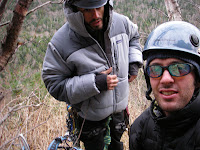 The Mellor "guidebible" acknowledges that the first few pitches are somewhat unknown, so we proceeded to find our own route to the prominent "Gourmet" dihedral.
The Mellor "guidebible" acknowledges that the first few pitches are somewhat unknown, so we proceeded to find our own route to the prominent "Gourmet" dihedral. It took us the whole first day, after completing the 5 mile approach, to do those first few pitches.
Dave started us out with a short pitch around a bulge in his mountaineering boots. I followed, wearing the entirely overkill 70L Naos pack (to see how climbing in it felt...it didn't feel good), which put us under a blank, overhanging bulge.
Following a crumbly horizontal crack, I led left under the bulge, looking for a weakness. 100' feet later, with killer rope drag and sketchy microcams for pro, I found a hanging belay below a promising crack, which broke through the bulge.
Dave took the thin crack to a short head wall below a ledge, pulling committing ~5.9 moves on PG13 gear with a shit-eating grin on his face the whole time.
It appeared that it was a simple low angle, scrambly pitch that separated us from the massive ledge at the base of the "hang ten" dihedral. I set off, executing a hard boulder move to link blocky sections, then continued on a mossy, wet and dirty, low angle section on wishful pro. A brief slip on wet moss, twenty feet up from a muddy cam, had my heart leap from my chest. Slinging a demoralized clump of brush, I got my heart under control and finished the pitch.
By the time Dave joined me on the ledge, it was dark. Bundled up in our belay jackets, we fixed our two ropes and rapped by headlamp.
Pasta, sausage and a bit of whiskey warmed us up back at the cave, and we got a good night sleep, with only a couple interruptions from the mice sharing our camp.
The morning sun warmed us, as well as the clifftop ice, which would periodically break off, whiz through the air like incoming artillery and explode off rocks around us as we jugged our fixed lines.
I picked up where we left off and headed up the impressive, overhanging dihedral that is the "hang ten" pitch. Dirty hand jams and crumbly face holds for feet got me up the first half, and also through my larger cams. Thinking I would need them for the rest of the way, I built an anchor and back-cleaned.
It turns out that "hang ten" follows a thin seam out to left, from my mid-way anchor, which would have used smaller gear that I had plenty of... (Apparently the last moves of this exit have you hanging by all ten fingers, with no feet...hence, "hang ten.")
Anyhow, at the time, I wasn't sure that the left exit was the way to go. Having retrieved my #2 and #3s and my #4, I went to work on the dirty, licheny, offwidthy, jammy continuation of the crack I had been following thus far. I thrutched up into the crux of the off-route off-width to find myself hanging on a solid, but nauseatingly stressful arm jam. Plugging a tenuous #4, I had myself a little rest on the rope, then finished the last few moves.
I was glad to be at the top, but felt unsatisfied by my inefficiency and hang on the pitch.
Dave came up, then led through a short low angle section with one very hard boulder move to gain a ledge. I followed, employing a stout bush to pull through the crux.
Route finding uncertainty necessitated a short rap and traverse to the beginning the final dihedral/face.
Dave started up just as it was getting dark. The moves were thin and it was eating up gear, with no good prospects for a belay stance.
Finally, route uncertainty, complete darkness and freezing temperatures compelled us to bail.
We rapped through the night and returned to our cave around 1030pm.
A closer look at the guide book revealed that the first ascent party for "hang ten" tried to free that last section, but were turned back by rain (explaining the fixed hex we found).
The next morning we lazed around in our sleeping bags as it snowed for a few hours. Then packed up and hiked out in glorious sunlight.
All in all we thought the trip was quite a success. We climbed at our limits on poor gear with difficult route finding, in freezing temps and in the dark. We can't wait to return.
Epilogue:
-Dave and I corresponded with the authors of the new Dacks guide and our first four pitches are now in the new guide book as "P-Town Approach 5.10b PG-13 350'." Much thanks to Jim Lawyer and Jeremy Haas for the opportunity to contribute. We're ecstatic to have our first first ascent.

No comments:
Post a Comment